Accounting Information System Report for Adam & Co
VerifiedAdded on 2022/12/14
|15
|2687
|294
Report
AI Summary
This report provides a comprehensive overview of Accounting Information Systems (AIS). It begins with an executive summary and introduces the concept of AIS, emphasizing its importance in modern business environments for strategic decision-making. The report details the core principles of AIS, including source documents, data collection devices, processing devices, storage devices, and output methods. It then delves into the six key components: people, procedures and instructions, data, software, IT infrastructure, and internal controls. Furthermore, the report explores three main types of AIS: purchasing systems, cash disbursement systems, and payroll systems, discussing their functions, advantages, and disadvantages. The conclusion highlights the role of AIS in enhancing efficiency, cost-effectiveness, and decision-making within organizations, emphasizing the importance of a well-managed AIS for business success. The report includes a reference list of sources used.
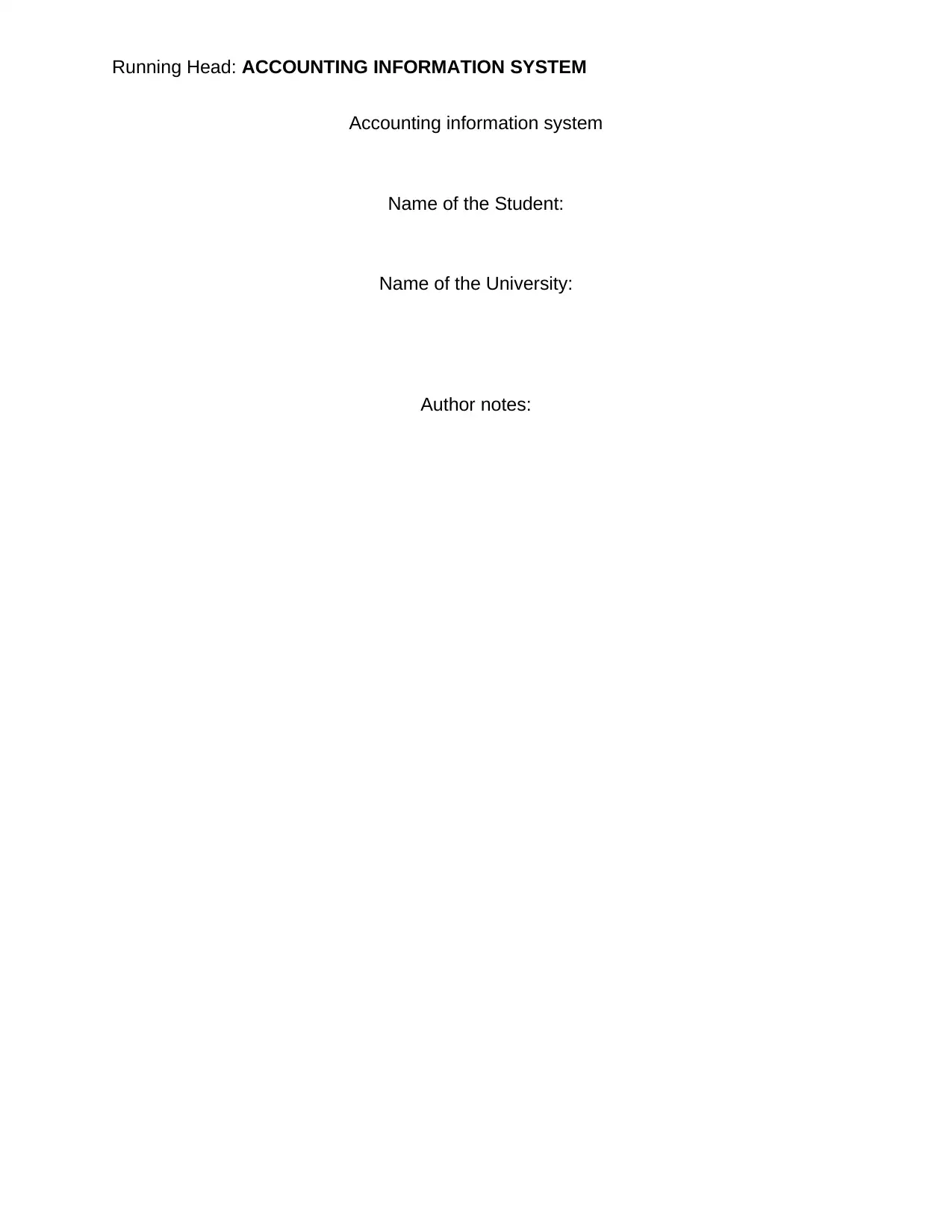
Running Head: ACCOUNTING INFORMATION SYSTEM
Accounting information system
Name of the Student:
Name of the University:
Author notes:
Accounting information system
Name of the Student:
Name of the University:
Author notes:
Paraphrase This Document
Need a fresh take? Get an instant paraphrase of this document with our AI Paraphraser
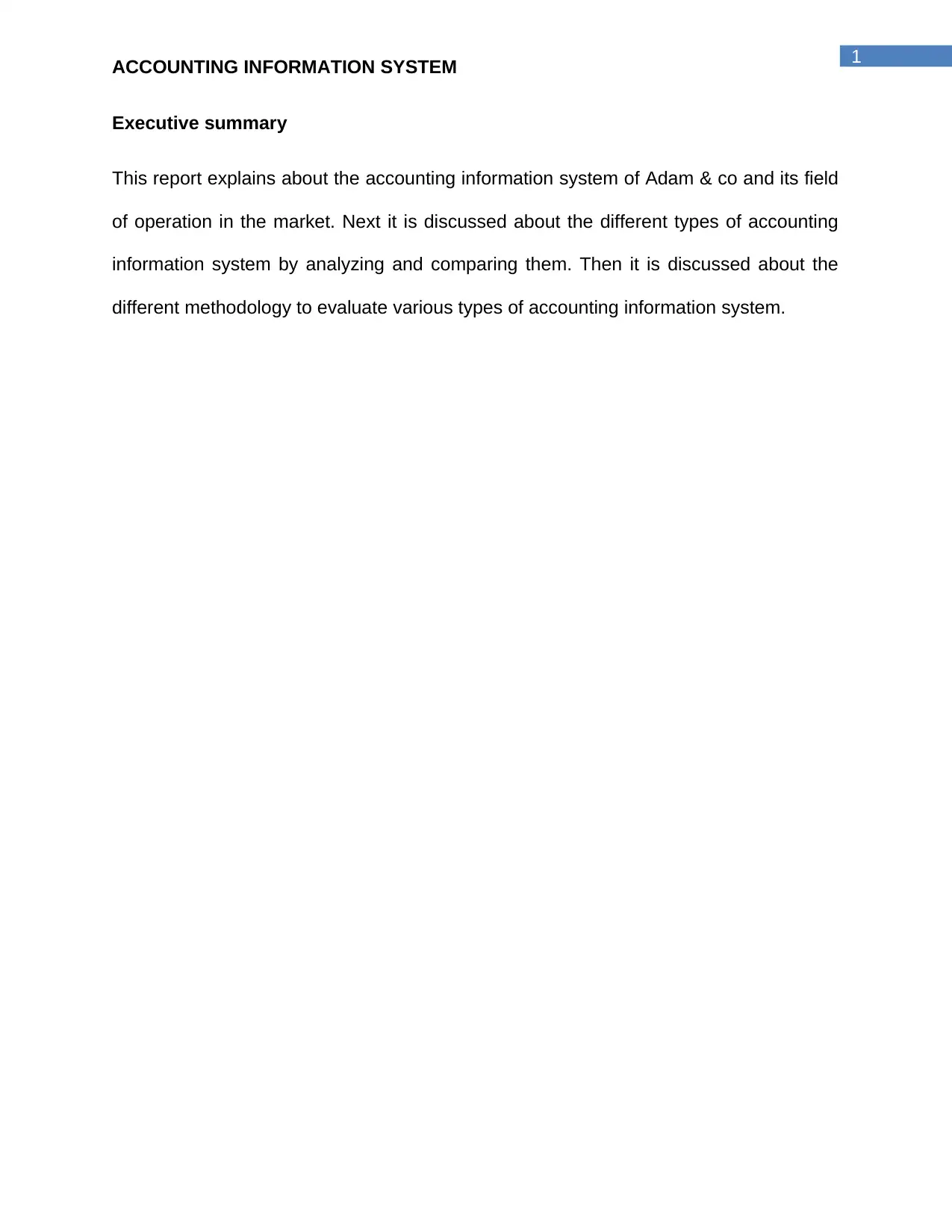
1
ACCOUNTING INFORMATION SYSTEM
Executive summary
This report explains about the accounting information system of Adam & co and its field
of operation in the market. Next it is discussed about the different types of accounting
information system by analyzing and comparing them. Then it is discussed about the
different methodology to evaluate various types of accounting information system.
ACCOUNTING INFORMATION SYSTEM
Executive summary
This report explains about the accounting information system of Adam & co and its field
of operation in the market. Next it is discussed about the different types of accounting
information system by analyzing and comparing them. Then it is discussed about the
different methodology to evaluate various types of accounting information system.
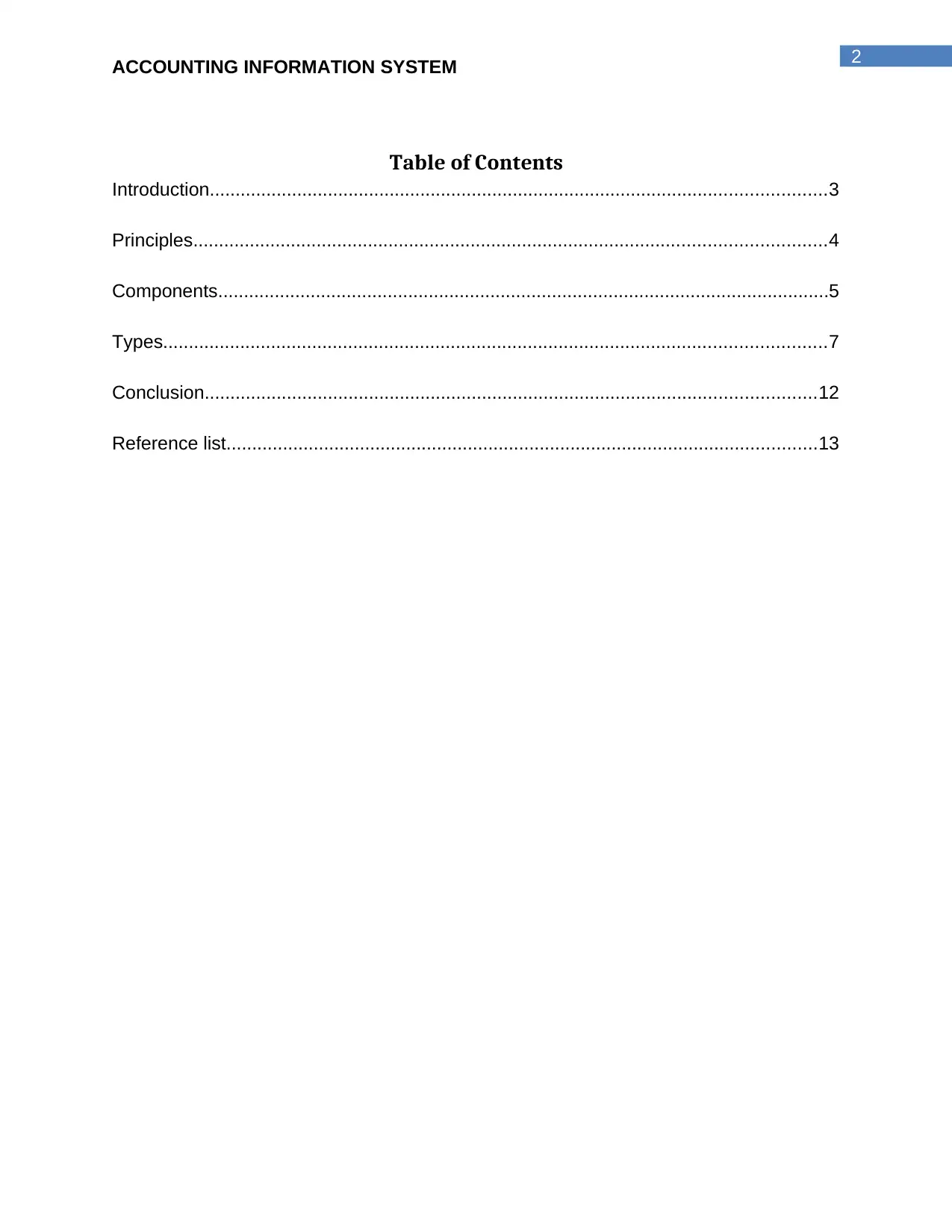
2
ACCOUNTING INFORMATION SYSTEM
Table of Contents
Introduction........................................................................................................................3
Principles...........................................................................................................................4
Components.......................................................................................................................5
Types.................................................................................................................................7
Conclusion.......................................................................................................................12
Reference list...................................................................................................................13
ACCOUNTING INFORMATION SYSTEM
Table of Contents
Introduction........................................................................................................................3
Principles...........................................................................................................................4
Components.......................................................................................................................5
Types.................................................................................................................................7
Conclusion.......................................................................................................................12
Reference list...................................................................................................................13
⊘ This is a preview!⊘
Do you want full access?
Subscribe today to unlock all pages.

Trusted by 1+ million students worldwide
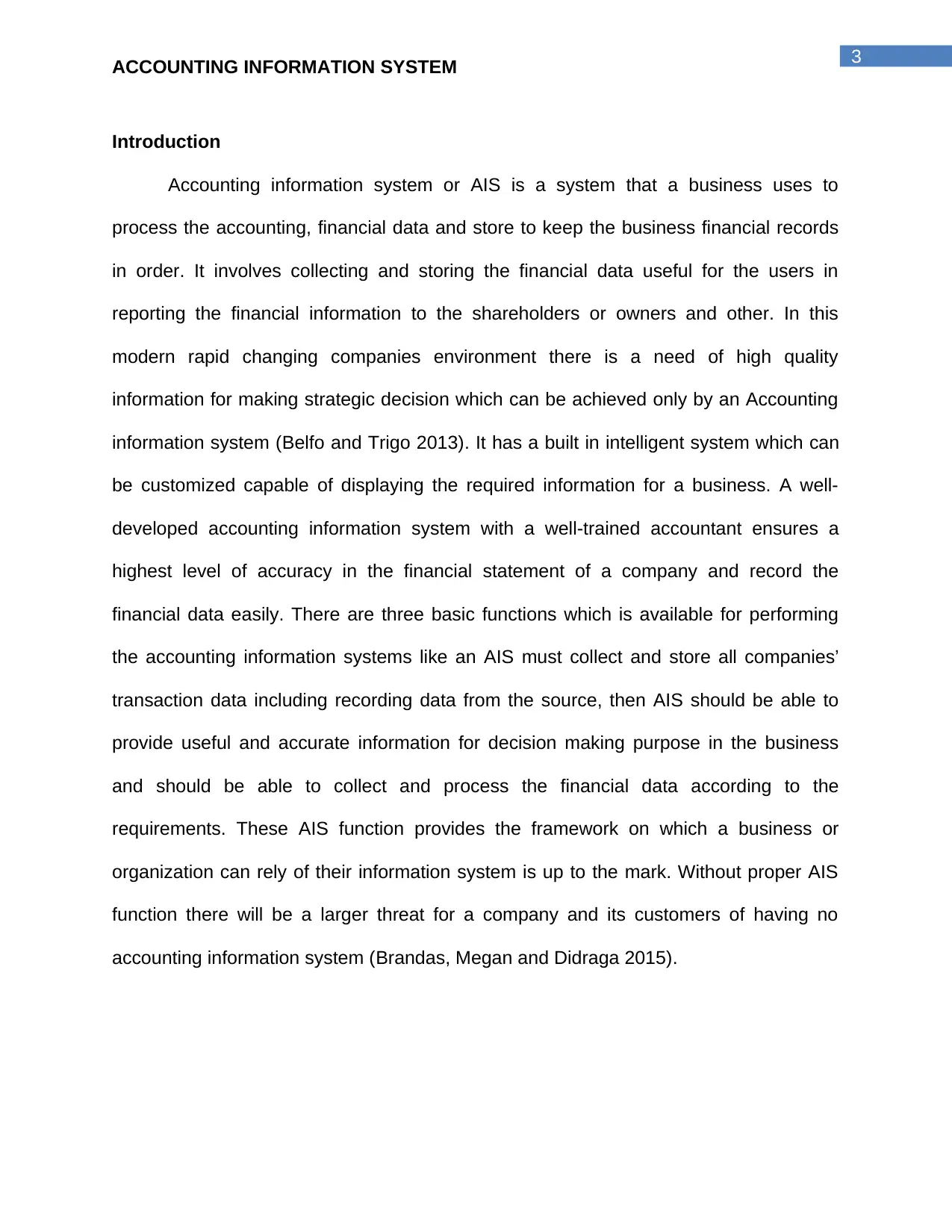
3
ACCOUNTING INFORMATION SYSTEM
Introduction
Accounting information system or AIS is a system that a business uses to
process the accounting, financial data and store to keep the business financial records
in order. It involves collecting and storing the financial data useful for the users in
reporting the financial information to the shareholders or owners and other. In this
modern rapid changing companies environment there is a need of high quality
information for making strategic decision which can be achieved only by an Accounting
information system (Belfo and Trigo 2013). It has a built in intelligent system which can
be customized capable of displaying the required information for a business. A well-
developed accounting information system with a well-trained accountant ensures a
highest level of accuracy in the financial statement of a company and record the
financial data easily. There are three basic functions which is available for performing
the accounting information systems like an AIS must collect and store all companies’
transaction data including recording data from the source, then AIS should be able to
provide useful and accurate information for decision making purpose in the business
and should be able to collect and process the financial data according to the
requirements. These AIS function provides the framework on which a business or
organization can rely of their information system is up to the mark. Without proper AIS
function there will be a larger threat for a company and its customers of having no
accounting information system (Brandas, Megan and Didraga 2015).
ACCOUNTING INFORMATION SYSTEM
Introduction
Accounting information system or AIS is a system that a business uses to
process the accounting, financial data and store to keep the business financial records
in order. It involves collecting and storing the financial data useful for the users in
reporting the financial information to the shareholders or owners and other. In this
modern rapid changing companies environment there is a need of high quality
information for making strategic decision which can be achieved only by an Accounting
information system (Belfo and Trigo 2013). It has a built in intelligent system which can
be customized capable of displaying the required information for a business. A well-
developed accounting information system with a well-trained accountant ensures a
highest level of accuracy in the financial statement of a company and record the
financial data easily. There are three basic functions which is available for performing
the accounting information systems like an AIS must collect and store all companies’
transaction data including recording data from the source, then AIS should be able to
provide useful and accurate information for decision making purpose in the business
and should be able to collect and process the financial data according to the
requirements. These AIS function provides the framework on which a business or
organization can rely of their information system is up to the mark. Without proper AIS
function there will be a larger threat for a company and its customers of having no
accounting information system (Brandas, Megan and Didraga 2015).
Paraphrase This Document
Need a fresh take? Get an instant paraphrase of this document with our AI Paraphraser
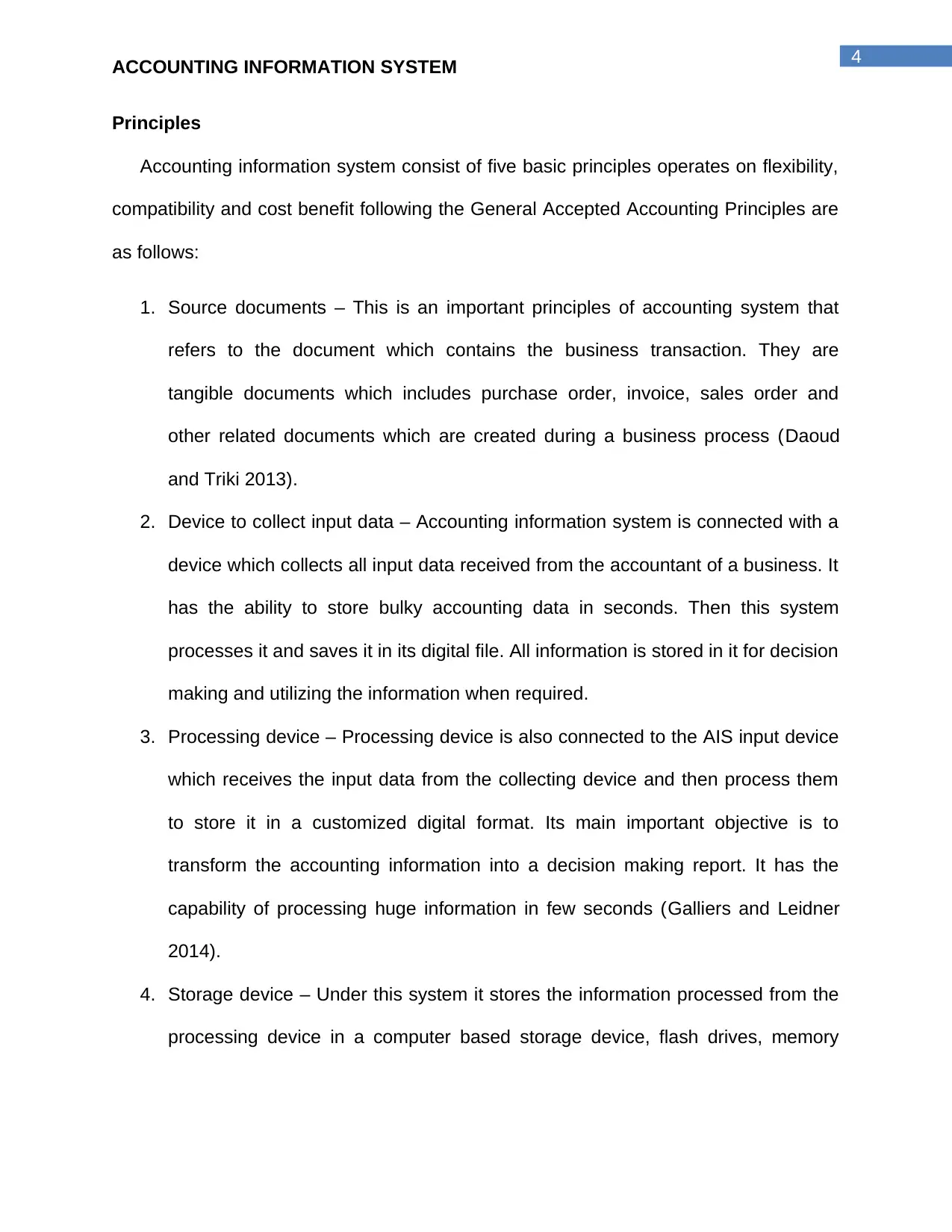
4
ACCOUNTING INFORMATION SYSTEM
Principles
Accounting information system consist of five basic principles operates on flexibility,
compatibility and cost benefit following the General Accepted Accounting Principles are
as follows:
1. Source documents – This is an important principles of accounting system that
refers to the document which contains the business transaction. They are
tangible documents which includes purchase order, invoice, sales order and
other related documents which are created during a business process (Daoud
and Triki 2013).
2. Device to collect input data – Accounting information system is connected with a
device which collects all input data received from the accountant of a business. It
has the ability to store bulky accounting data in seconds. Then this system
processes it and saves it in its digital file. All information is stored in it for decision
making and utilizing the information when required.
3. Processing device – Processing device is also connected to the AIS input device
which receives the input data from the collecting device and then process them
to store it in a customized digital format. Its main important objective is to
transform the accounting information into a decision making report. It has the
capability of processing huge information in few seconds (Galliers and Leidner
2014).
4. Storage device – Under this system it stores the information processed from the
processing device in a computer based storage device, flash drives, memory
ACCOUNTING INFORMATION SYSTEM
Principles
Accounting information system consist of five basic principles operates on flexibility,
compatibility and cost benefit following the General Accepted Accounting Principles are
as follows:
1. Source documents – This is an important principles of accounting system that
refers to the document which contains the business transaction. They are
tangible documents which includes purchase order, invoice, sales order and
other related documents which are created during a business process (Daoud
and Triki 2013).
2. Device to collect input data – Accounting information system is connected with a
device which collects all input data received from the accountant of a business. It
has the ability to store bulky accounting data in seconds. Then this system
processes it and saves it in its digital file. All information is stored in it for decision
making and utilizing the information when required.
3. Processing device – Processing device is also connected to the AIS input device
which receives the input data from the collecting device and then process them
to store it in a customized digital format. Its main important objective is to
transform the accounting information into a decision making report. It has the
capability of processing huge information in few seconds (Galliers and Leidner
2014).
4. Storage device – Under this system it stores the information processed from the
processing device in a computer based storage device, flash drives, memory
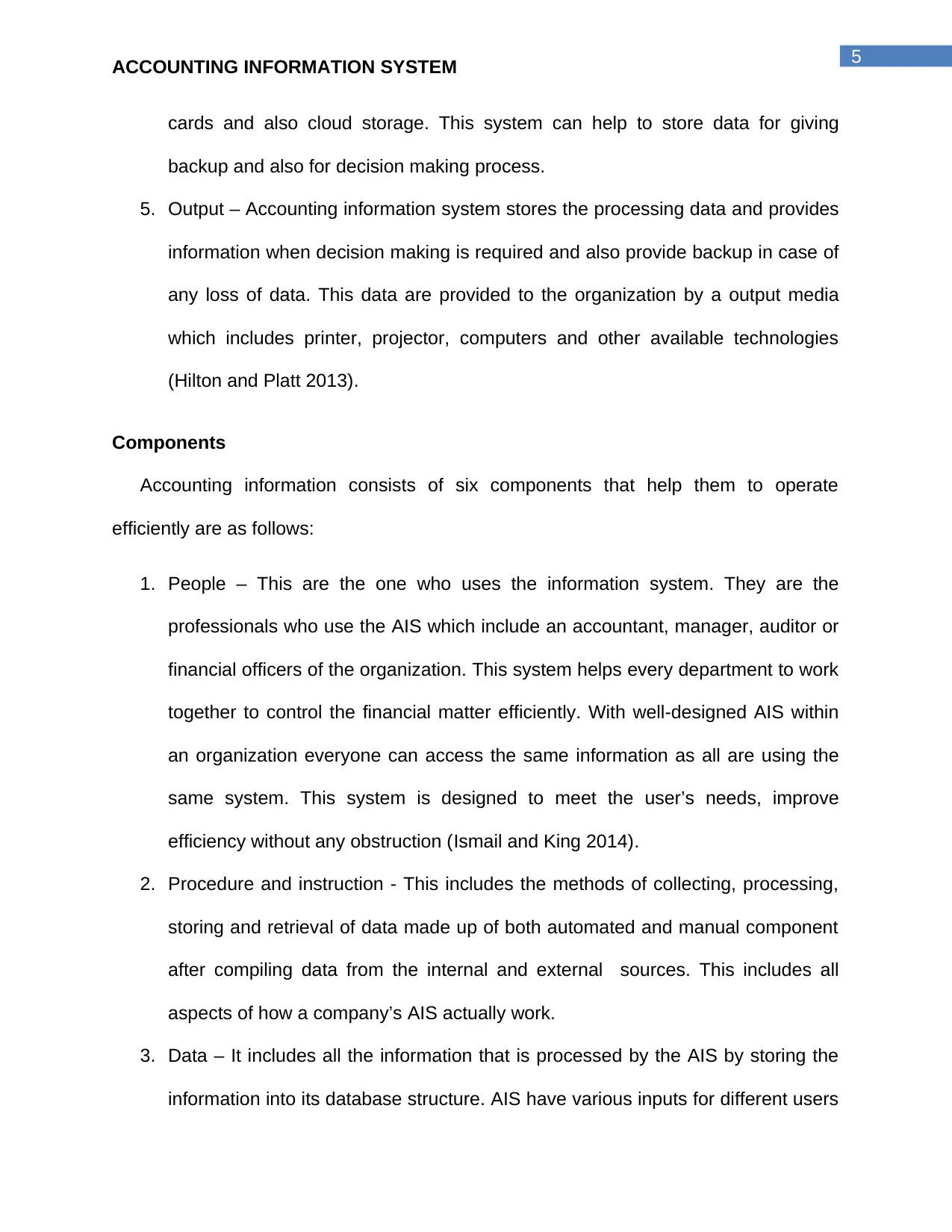
5
ACCOUNTING INFORMATION SYSTEM
cards and also cloud storage. This system can help to store data for giving
backup and also for decision making process.
5. Output – Accounting information system stores the processing data and provides
information when decision making is required and also provide backup in case of
any loss of data. This data are provided to the organization by a output media
which includes printer, projector, computers and other available technologies
(Hilton and Platt 2013).
Components
Accounting information consists of six components that help them to operate
efficiently are as follows:
1. People – This are the one who uses the information system. They are the
professionals who use the AIS which include an accountant, manager, auditor or
financial officers of the organization. This system helps every department to work
together to control the financial matter efficiently. With well-designed AIS within
an organization everyone can access the same information as all are using the
same system. This system is designed to meet the user’s needs, improve
efficiency without any obstruction (Ismail and King 2014).
2. Procedure and instruction - This includes the methods of collecting, processing,
storing and retrieval of data made up of both automated and manual component
after compiling data from the internal and external sources. This includes all
aspects of how a company’s AIS actually work.
3. Data – It includes all the information that is processed by the AIS by storing the
information into its database structure. AIS have various inputs for different users
ACCOUNTING INFORMATION SYSTEM
cards and also cloud storage. This system can help to store data for giving
backup and also for decision making process.
5. Output – Accounting information system stores the processing data and provides
information when decision making is required and also provide backup in case of
any loss of data. This data are provided to the organization by a output media
which includes printer, projector, computers and other available technologies
(Hilton and Platt 2013).
Components
Accounting information consists of six components that help them to operate
efficiently are as follows:
1. People – This are the one who uses the information system. They are the
professionals who use the AIS which include an accountant, manager, auditor or
financial officers of the organization. This system helps every department to work
together to control the financial matter efficiently. With well-designed AIS within
an organization everyone can access the same information as all are using the
same system. This system is designed to meet the user’s needs, improve
efficiency without any obstruction (Ismail and King 2014).
2. Procedure and instruction - This includes the methods of collecting, processing,
storing and retrieval of data made up of both automated and manual component
after compiling data from the internal and external sources. This includes all
aspects of how a company’s AIS actually work.
3. Data – It includes all the information that is processed by the AIS by storing the
information into its database structure. AIS have various inputs for different users
⊘ This is a preview!⊘
Do you want full access?
Subscribe today to unlock all pages.

Trusted by 1+ million students worldwide
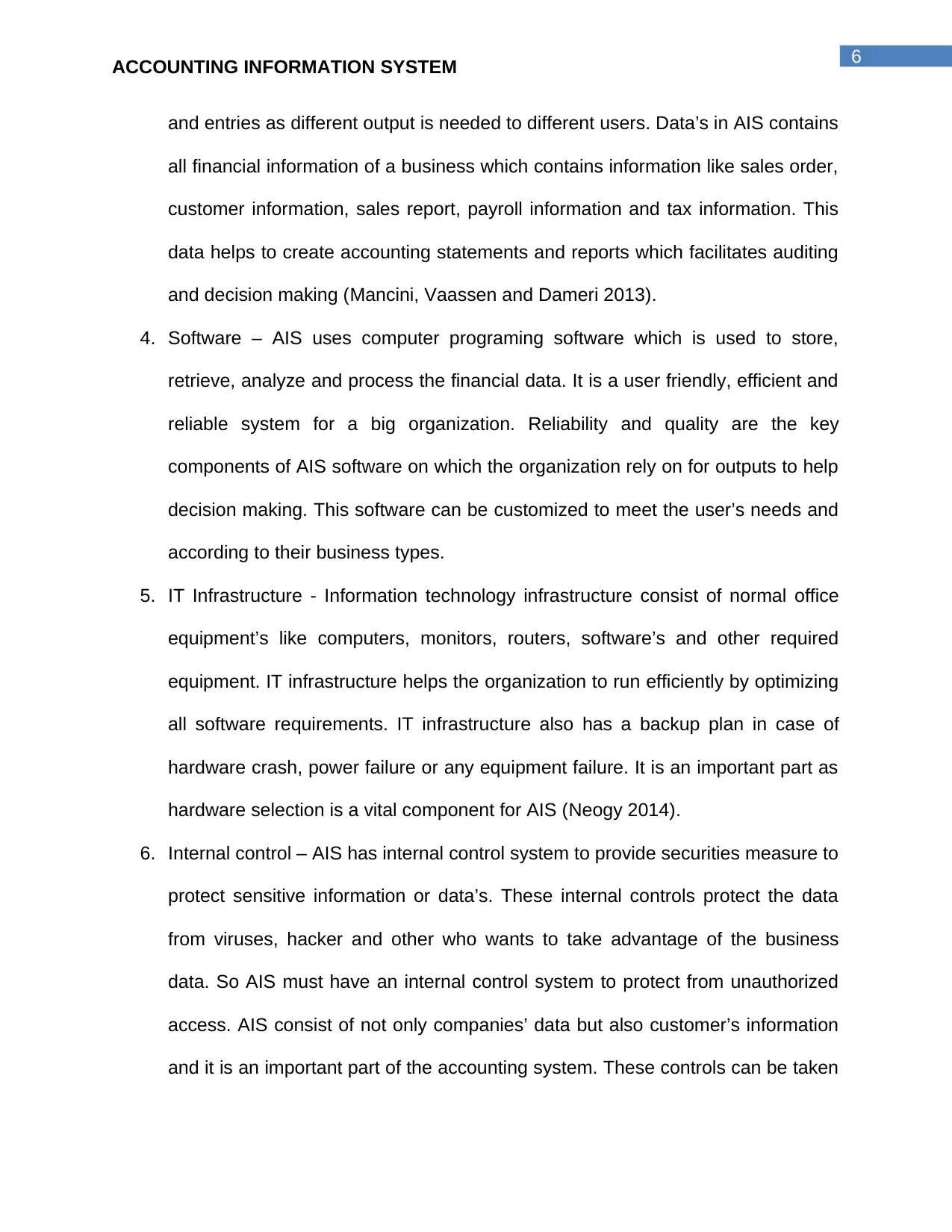
6
ACCOUNTING INFORMATION SYSTEM
and entries as different output is needed to different users. Data’s in AIS contains
all financial information of a business which contains information like sales order,
customer information, sales report, payroll information and tax information. This
data helps to create accounting statements and reports which facilitates auditing
and decision making (Mancini, Vaassen and Dameri 2013).
4. Software – AIS uses computer programing software which is used to store,
retrieve, analyze and process the financial data. It is a user friendly, efficient and
reliable system for a big organization. Reliability and quality are the key
components of AIS software on which the organization rely on for outputs to help
decision making. This software can be customized to meet the user’s needs and
according to their business types.
5. IT Infrastructure - Information technology infrastructure consist of normal office
equipment’s like computers, monitors, routers, software’s and other required
equipment. IT infrastructure helps the organization to run efficiently by optimizing
all software requirements. IT infrastructure also has a backup plan in case of
hardware crash, power failure or any equipment failure. It is an important part as
hardware selection is a vital component for AIS (Neogy 2014).
6. Internal control – AIS has internal control system to provide securities measure to
protect sensitive information or data’s. These internal controls protect the data
from viruses, hacker and other who wants to take advantage of the business
data. So AIS must have an internal control system to protect from unauthorized
access. AIS consist of not only companies’ data but also customer’s information
and it is an important part of the accounting system. These controls can be taken
ACCOUNTING INFORMATION SYSTEM
and entries as different output is needed to different users. Data’s in AIS contains
all financial information of a business which contains information like sales order,
customer information, sales report, payroll information and tax information. This
data helps to create accounting statements and reports which facilitates auditing
and decision making (Mancini, Vaassen and Dameri 2013).
4. Software – AIS uses computer programing software which is used to store,
retrieve, analyze and process the financial data. It is a user friendly, efficient and
reliable system for a big organization. Reliability and quality are the key
components of AIS software on which the organization rely on for outputs to help
decision making. This software can be customized to meet the user’s needs and
according to their business types.
5. IT Infrastructure - Information technology infrastructure consist of normal office
equipment’s like computers, monitors, routers, software’s and other required
equipment. IT infrastructure helps the organization to run efficiently by optimizing
all software requirements. IT infrastructure also has a backup plan in case of
hardware crash, power failure or any equipment failure. It is an important part as
hardware selection is a vital component for AIS (Neogy 2014).
6. Internal control – AIS has internal control system to provide securities measure to
protect sensitive information or data’s. These internal controls protect the data
from viruses, hacker and other who wants to take advantage of the business
data. So AIS must have an internal control system to protect from unauthorized
access. AIS consist of not only companies’ data but also customer’s information
and it is an important part of the accounting system. These controls can be taken
Paraphrase This Document
Need a fresh take? Get an instant paraphrase of this document with our AI Paraphraser
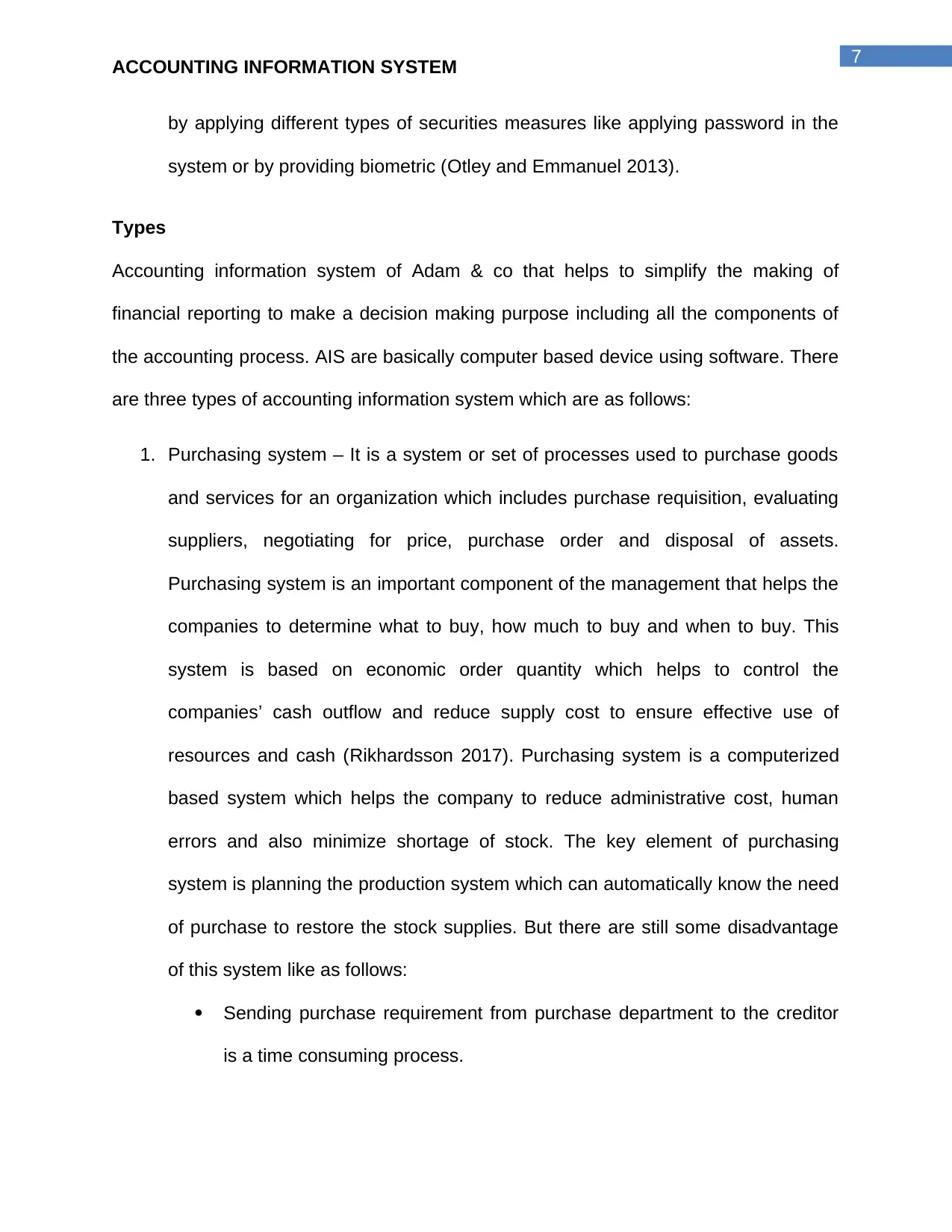
7
ACCOUNTING INFORMATION SYSTEM
by applying different types of securities measures like applying password in the
system or by providing biometric (Otley and Emmanuel 2013).
Types
Accounting information system of Adam & co that helps to simplify the making of
financial reporting to make a decision making purpose including all the components of
the accounting process. AIS are basically computer based device using software. There
are three types of accounting information system which are as follows:
1. Purchasing system – It is a system or set of processes used to purchase goods
and services for an organization which includes purchase requisition, evaluating
suppliers, negotiating for price, purchase order and disposal of assets.
Purchasing system is an important component of the management that helps the
companies to determine what to buy, how much to buy and when to buy. This
system is based on economic order quantity which helps to control the
companies’ cash outflow and reduce supply cost to ensure effective use of
resources and cash (Rikhardsson 2017). Purchasing system is a computerized
based system which helps the company to reduce administrative cost, human
errors and also minimize shortage of stock. The key element of purchasing
system is planning the production system which can automatically know the need
of purchase to restore the stock supplies. But there are still some disadvantage
of this system like as follows:
Sending purchase requirement from purchase department to the creditor
is a time consuming process.
ACCOUNTING INFORMATION SYSTEM
by applying different types of securities measures like applying password in the
system or by providing biometric (Otley and Emmanuel 2013).
Types
Accounting information system of Adam & co that helps to simplify the making of
financial reporting to make a decision making purpose including all the components of
the accounting process. AIS are basically computer based device using software. There
are three types of accounting information system which are as follows:
1. Purchasing system – It is a system or set of processes used to purchase goods
and services for an organization which includes purchase requisition, evaluating
suppliers, negotiating for price, purchase order and disposal of assets.
Purchasing system is an important component of the management that helps the
companies to determine what to buy, how much to buy and when to buy. This
system is based on economic order quantity which helps to control the
companies’ cash outflow and reduce supply cost to ensure effective use of
resources and cash (Rikhardsson 2017). Purchasing system is a computerized
based system which helps the company to reduce administrative cost, human
errors and also minimize shortage of stock. The key element of purchasing
system is planning the production system which can automatically know the need
of purchase to restore the stock supplies. But there are still some disadvantage
of this system like as follows:
Sending purchase requirement from purchase department to the creditor
is a time consuming process.
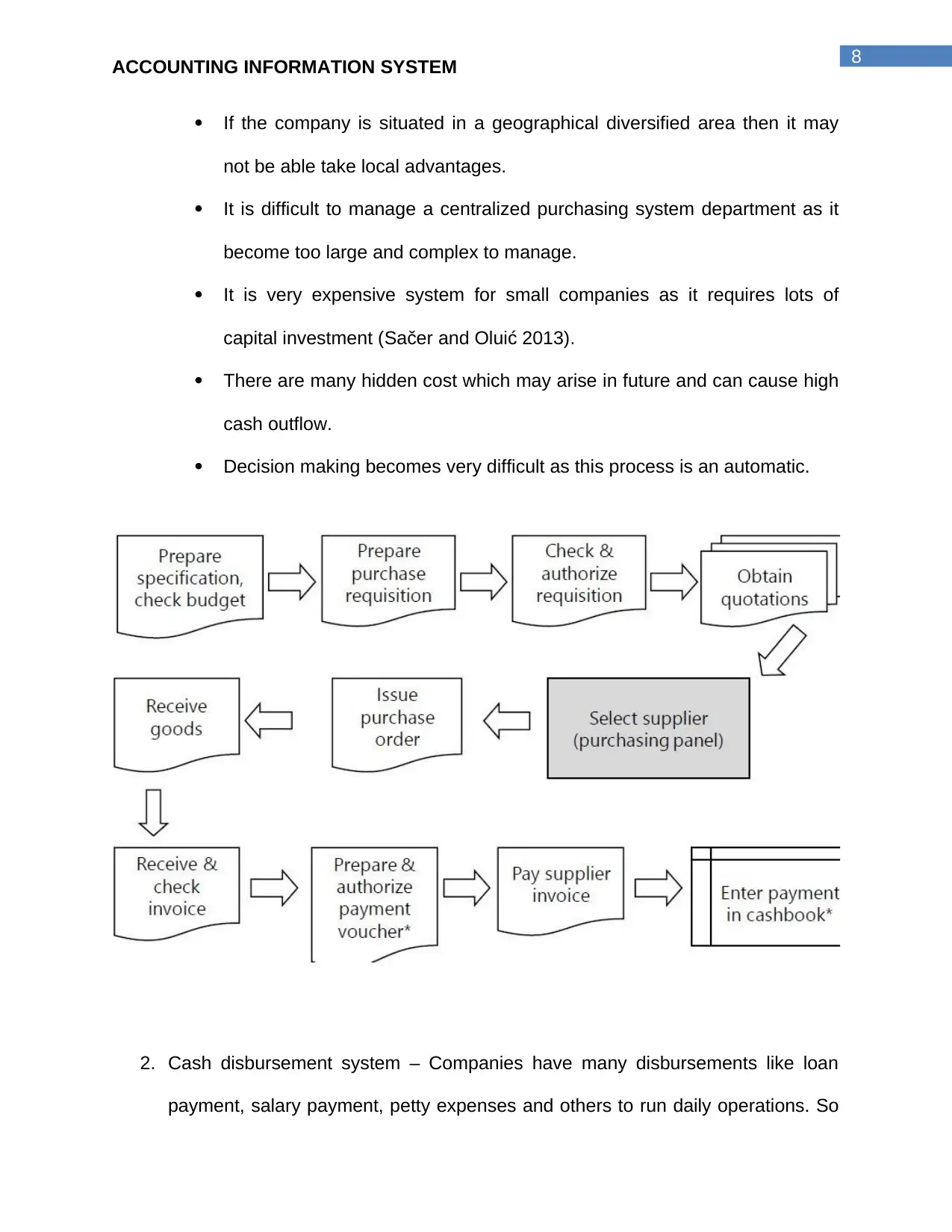
8
ACCOUNTING INFORMATION SYSTEM
If the company is situated in a geographical diversified area then it may
not be able take local advantages.
It is difficult to manage a centralized purchasing system department as it
become too large and complex to manage.
It is very expensive system for small companies as it requires lots of
capital investment (Sačer and Oluić 2013).
There are many hidden cost which may arise in future and can cause high
cash outflow.
Decision making becomes very difficult as this process is an automatic.
2. Cash disbursement system – Companies have many disbursements like loan
payment, salary payment, petty expenses and others to run daily operations. So
ACCOUNTING INFORMATION SYSTEM
If the company is situated in a geographical diversified area then it may
not be able take local advantages.
It is difficult to manage a centralized purchasing system department as it
become too large and complex to manage.
It is very expensive system for small companies as it requires lots of
capital investment (Sačer and Oluić 2013).
There are many hidden cost which may arise in future and can cause high
cash outflow.
Decision making becomes very difficult as this process is an automatic.
2. Cash disbursement system – Companies have many disbursements like loan
payment, salary payment, petty expenses and others to run daily operations. So
⊘ This is a preview!⊘
Do you want full access?
Subscribe today to unlock all pages.

Trusted by 1+ million students worldwide
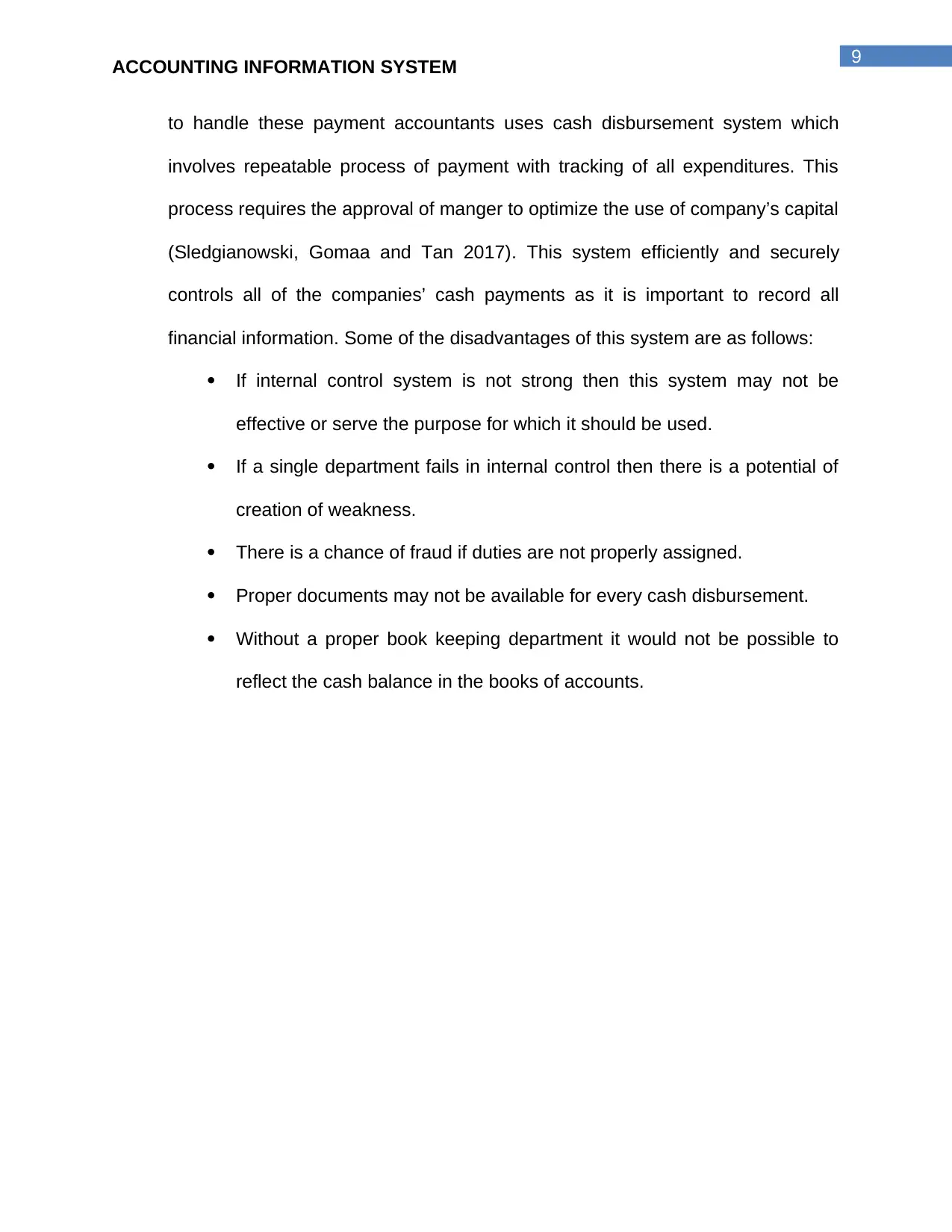
9
ACCOUNTING INFORMATION SYSTEM
to handle these payment accountants uses cash disbursement system which
involves repeatable process of payment with tracking of all expenditures. This
process requires the approval of manger to optimize the use of company’s capital
(Sledgianowski, Gomaa and Tan 2017). This system efficiently and securely
controls all of the companies’ cash payments as it is important to record all
financial information. Some of the disadvantages of this system are as follows:
If internal control system is not strong then this system may not be
effective or serve the purpose for which it should be used.
If a single department fails in internal control then there is a potential of
creation of weakness.
There is a chance of fraud if duties are not properly assigned.
Proper documents may not be available for every cash disbursement.
Without a proper book keeping department it would not be possible to
reflect the cash balance in the books of accounts.
ACCOUNTING INFORMATION SYSTEM
to handle these payment accountants uses cash disbursement system which
involves repeatable process of payment with tracking of all expenditures. This
process requires the approval of manger to optimize the use of company’s capital
(Sledgianowski, Gomaa and Tan 2017). This system efficiently and securely
controls all of the companies’ cash payments as it is important to record all
financial information. Some of the disadvantages of this system are as follows:
If internal control system is not strong then this system may not be
effective or serve the purpose for which it should be used.
If a single department fails in internal control then there is a potential of
creation of weakness.
There is a chance of fraud if duties are not properly assigned.
Proper documents may not be available for every cash disbursement.
Without a proper book keeping department it would not be possible to
reflect the cash balance in the books of accounts.
Paraphrase This Document
Need a fresh take? Get an instant paraphrase of this document with our AI Paraphraser
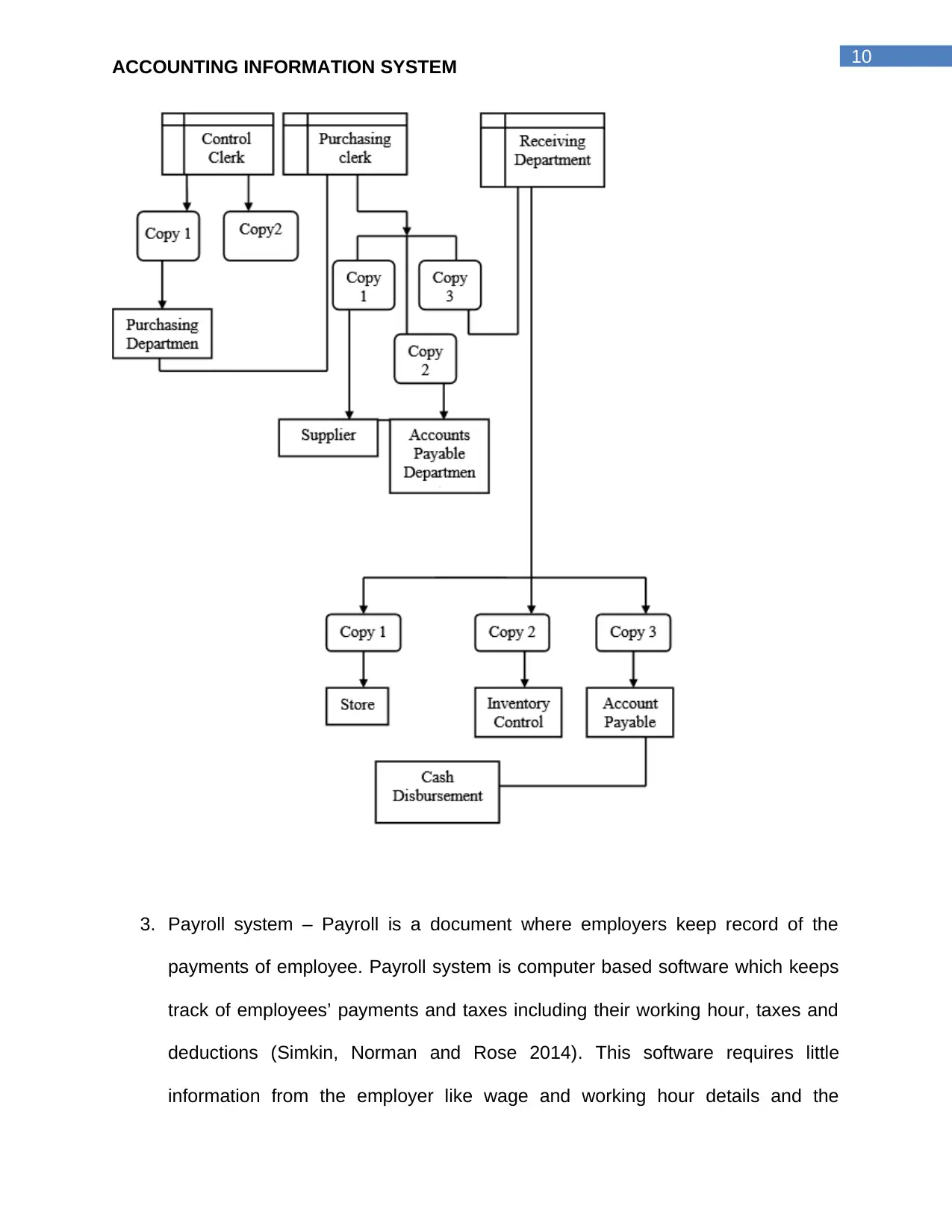
10
ACCOUNTING INFORMATION SYSTEM
3. Payroll system – Payroll is a document where employers keep record of the
payments of employee. Payroll system is computer based software which keeps
track of employees’ payments and taxes including their working hour, taxes and
deductions (Simkin, Norman and Rose 2014). This software requires little
information from the employer like wage and working hour details and the
ACCOUNTING INFORMATION SYSTEM
3. Payroll system – Payroll is a document where employers keep record of the
payments of employee. Payroll system is computer based software which keeps
track of employees’ payments and taxes including their working hour, taxes and
deductions (Simkin, Norman and Rose 2014). This software requires little
information from the employer like wage and working hour details and the
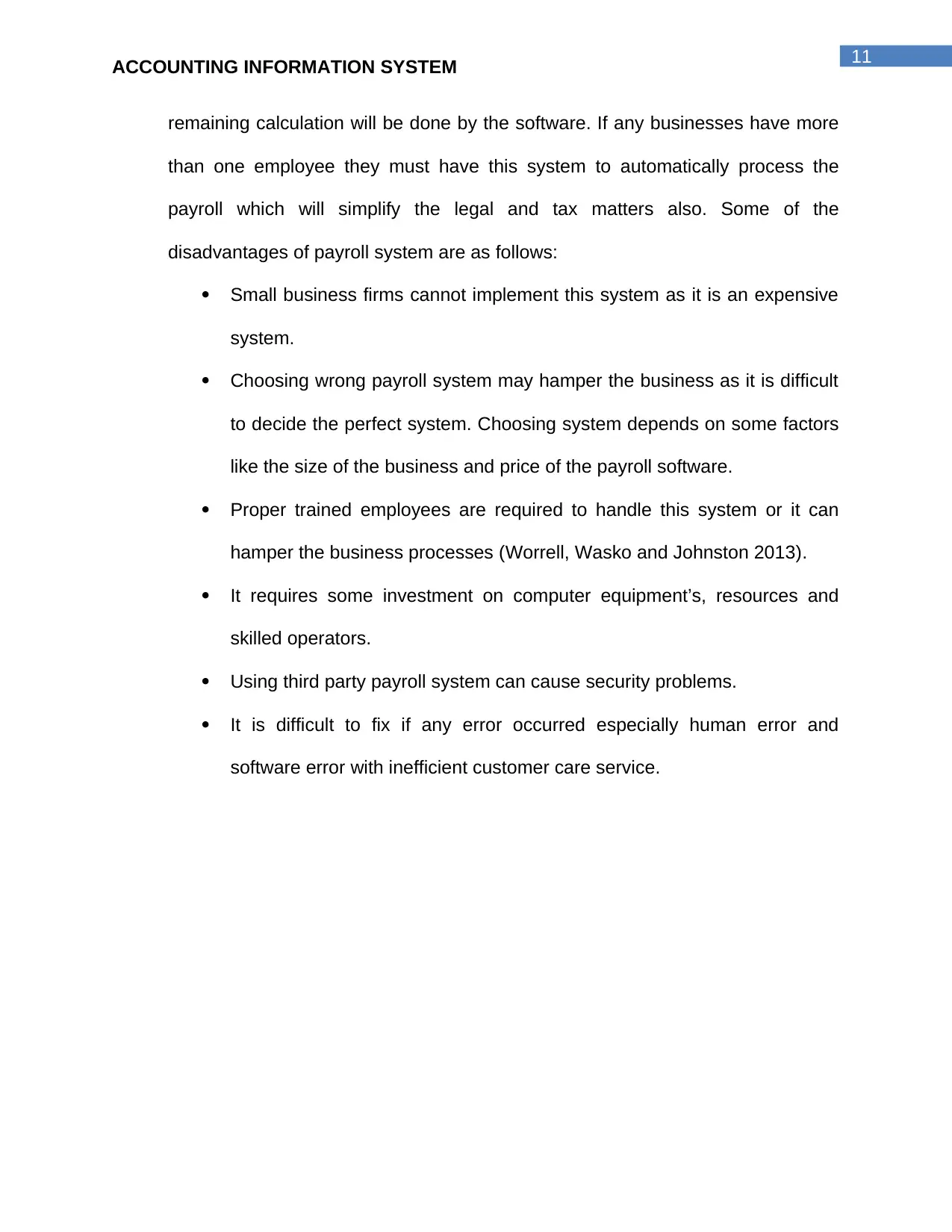
11
ACCOUNTING INFORMATION SYSTEM
remaining calculation will be done by the software. If any businesses have more
than one employee they must have this system to automatically process the
payroll which will simplify the legal and tax matters also. Some of the
disadvantages of payroll system are as follows:
Small business firms cannot implement this system as it is an expensive
system.
Choosing wrong payroll system may hamper the business as it is difficult
to decide the perfect system. Choosing system depends on some factors
like the size of the business and price of the payroll software.
Proper trained employees are required to handle this system or it can
hamper the business processes (Worrell, Wasko and Johnston 2013).
It requires some investment on computer equipment’s, resources and
skilled operators.
Using third party payroll system can cause security problems.
It is difficult to fix if any error occurred especially human error and
software error with inefficient customer care service.
ACCOUNTING INFORMATION SYSTEM
remaining calculation will be done by the software. If any businesses have more
than one employee they must have this system to automatically process the
payroll which will simplify the legal and tax matters also. Some of the
disadvantages of payroll system are as follows:
Small business firms cannot implement this system as it is an expensive
system.
Choosing wrong payroll system may hamper the business as it is difficult
to decide the perfect system. Choosing system depends on some factors
like the size of the business and price of the payroll software.
Proper trained employees are required to handle this system or it can
hamper the business processes (Worrell, Wasko and Johnston 2013).
It requires some investment on computer equipment’s, resources and
skilled operators.
Using third party payroll system can cause security problems.
It is difficult to fix if any error occurred especially human error and
software error with inefficient customer care service.
⊘ This is a preview!⊘
Do you want full access?
Subscribe today to unlock all pages.

Trusted by 1+ million students worldwide
1 out of 15
Related Documents
Your All-in-One AI-Powered Toolkit for Academic Success.
+13062052269
info@desklib.com
Available 24*7 on WhatsApp / Email
![[object Object]](/_next/static/media/star-bottom.7253800d.svg)
Unlock your academic potential
Copyright © 2020–2025 A2Z Services. All Rights Reserved. Developed and managed by ZUCOL.





